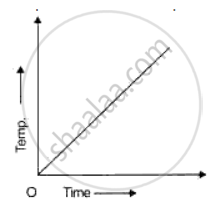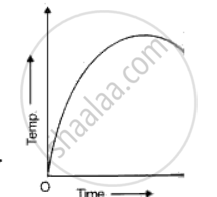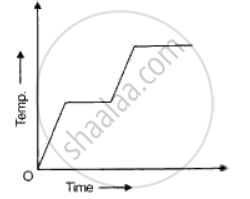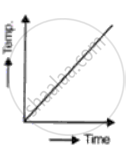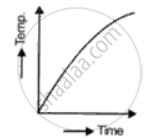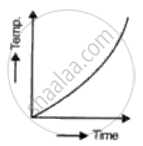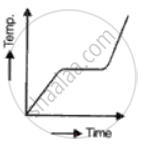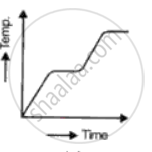Advertisements
Online Mock Tests
Chapters
![Frank solutions for Physics - Part 2 [English] Class 10 ICSE chapter 5 - Heat Frank solutions for Physics - Part 2 [English] Class 10 ICSE chapter 5 - Heat - Shaalaa.com](/images/physics-part-2-english-class-10-icse_6:39af211da77c495e91d1cf4305988990.PNG)
Advertisements
Solutions for Chapter 5: Heat
Below listed, you can find solutions for Chapter 5 of CISCE Frank for Physics - Part 2 [English] Class 10 ICSE.
Frank solutions for Physics - Part 2 [English] Class 10 ICSE 5 Heat Exercise 5.1 i [Page 233]
Which is bigger: 1 joule or 1 calorie?
Plot a graph taking oC on the Y-axis and the corresponding oF along the X-axis.
Plot a graph taking oF along the Y-axis and the corresponding oC on the X-axis.
Express -400C on the Fahrenheit scale.
Frank solutions for Physics - Part 2 [English] Class 10 ICSE 5 Heat Exercise 5.1 ii [Page 234]
Express the temperature of 0 K on the:
(a) Celsius scale
(b) Fahrenheit scale
Write the SI unit of:
(i) Amount of heat
(ii) Heat capacity
(iii) Specific Heat capacity
Give one example where high specific heat capacity of water is used as cooling.
Define the term 'heat capacity' and state its unit.
Define the term 'specific heat capacity' and state its unit.
0.5 kg of lemon squash at 300C is placed in a refrigerator which can remove heat at an average rate of 30 Js-1. How long will it take to cool the lemon squash to 50C?(Sp. heat capacity of lemon squash = 4200 J kg-1 oC-1.)
What is the principle of Calorimetry?
Frank solutions for Physics - Part 2 [English] Class 10 ICSE 5 Heat Exercise 5.2 i [Page 241]
What is the principle of Calorimetry?
The product of mass and specific heat is known as ..........
The amount of heat required to raise the temperature of a body by 10C is called .........
The substances like water which have ........... Heat capacity warm up more slowly than substances like iron which have .......... heat capacity.
What do you mean by the statement?
'The specific latent heat capacity of fusion of ice is 336 J per g'?
When a liquid is solidified, it many either expand or contract. As water freezes to form ice it ........... And .............. in volume by ............. per cent.
The physical quantity which does not change during change of state is ............. of the body.
What is the unit of heat capacity in CGS system?
1 cal g-1 °C-1 = ........... J kg-1 °C-1.
Frank solutions for Physics - Part 2 [English] Class 10 ICSE 5 Heat Exercise 5.2 ii [Page 242]
Temperature ............ When ice melts at 0°C.
Find the amount of heat required to convert 100 g of water at 1000C into steam at 100°C. Latent heat of vapourisation of water is 540 calg-1.
A substance is heated at a constant rate from a low temperature to a high temperature. A graph of temperature against time is shown in the figure. Which part or parts of the graph correspond(s) to the substance existing in two states?
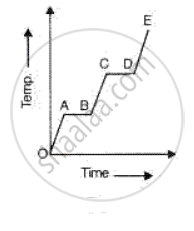
A solid is heated at a constant rate in an insulated container till half of it vaporizes. Which of the following graphs show the temperature changes during this time?
The graph given below represents a cooling curve fore a substance being cooled from a higher temperature to a lower temperature.
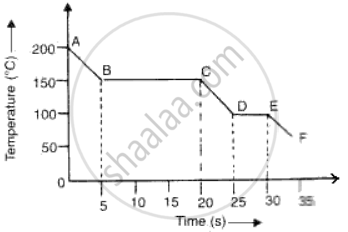
(a)What is the boiling point of the substance?
(b)What happens in the region DE?
(c)What is the melting point of the substance?
Frank solutions for Physics - Part 2 [English] Class 10 ICSE 5 Heat Exercise 5.2 iii [Page 243]
A slab of ice at -50°C is constantly heated till the steam attains a temperature of 150°C. Draw a graph showing the change of temperature with time. Label the various parts of graph properly.
A piece of ice is heated at a constant rate. The variation in temperature with time of heating is shown in the graph (see fig.)
(i) What is represented by AB?
(ii) What does CD represent?
(iii) What conclusion can you draw regarding the nature of ice from the graph below?

Frank solutions for Physics - Part 2 [English] Class 10 ICSE 5 Heat Exercise 1 [Page 245]
Make the correct choice in each of the following:
(a) In what unit is the specific heat capacity expressed?
J
J/kg°C
J/kg
kg/J°C
kg/J
(b) 2000 J of heat energy is required to raise the temperature of 4 kg of a
metal by 3°c. Which expression gives the specific heat capacity of the metal?
2000/( 4x3) J/kg°C
`2000/4` x 4 Jjkg°C
2000 x `4/3` J/kg°C
4 x `3/2000` J/kg°C
2000 x `3/4` J/kg°C
A substance is heated at a constant rate from a low temperature to a high
temperature. A graph of temperature against time is drawn and is shown in
fig. . Which part of parts of the graph corresponds to the substance existing
in two states?

All of it
OA, BC and DE
AB and CD
DE
CB
What change in heat energy occurs when lead at its melting point
solidifies without change in the temperature?
Latent heat is emitted.
Latent heat is absorbed.
Specific heat capacity is emitted.
Specific heat capacity is absorbed.
Both latent heat and specific heat are emitted.
A solid is heated at a constant rate in an insulated container till half of it
vapourises. Which graph in the following fig shows the temperature changes during this time?
Frank solutions for Physics - Part 2 [English] Class 10 ICSE 5 Heat Exercise 2 [Page 246]
Define heat capacity and state its units.
What amount of heat would be required to raise the temperature of 500 g of water from 30°C to 50°C? (sp. heat cap. of water= 4200 J/kg°C)
Sp. heat capacity of copper is 390 J/kg°C. What do you understand by this statement?
Calculate the amount of heat given out by 600 g of aluminium while cooling from 100oC to 30°C. (Sp. heat cap. of aluminium = 900 J/kgK.)
State the principle of calorimeter and define calorie and kilocalorie.
400 g of water at 80°C is mixed with 1 kg of water at 20°C. If the sp. heat cap. of water is 4200 J/kgK, find the final temperature of the mixture.
A burner raises the temperature of 360 g of water from 40°C to 100°C in 5 minutes. Calculate the rate of heat supplied by the burner.
A solid of mass 80 g at 80°C is dropped in 400 g water at 10°C. If final temp. is 30°C, find the sp. heat cap. of the solid.
A mass of 200 g of mercury at 100°C is poured into water at 20°C. If the final temperature of the mixture is 25°C, find the mass of water. (Sp. heat cap. of mercury is 140 J/kgK).
A piece of copper of mass 1 kg is dropped into 2 kg of water at 15°C. If the final temperature of the mixture is 40°C, calculate the intial temperature of copper.
A copper calorimeter of heat capacity 32 J/°C contains 100 g of oil at 30°C. 80 g of a metal of sp. heat cap. 0.12 J/g°C at 90°C is dropped into the oil and final temperature is 35°C. Calculate the sp. heat cap. of the oil.
Define the following terms:
(i) Latent heat,
(ii) Latent heat of fusion of ice.
Calculate the amount of heat required to change 40 G of ice at -10°C into water at 20°C. (sp. heat cap. of ice = 2.1 J/g°C, latent heat of fusion of ice = 330 j/g)
Define the following terms:
(i) Specific latent heat,
(ii) Specific latent heat of fusion.
What do you understand by the statement sp. latent heat of vapourisation of steam is 2268 J/kg?
Calculate the amount of heat given out while converting 100 g of water at 50°C into ice at -5°C. (refer Q.9 for data).
When steam at 100°C is passed through a hole drilled in a slab of ice at 0°C certain amount of ice melts. Find the amount of ice that melts. (sp. latent heat of fusion of ice = 336 J/g, sp. latent heat of vapourisation of steam = 2268 J/g, Sp. heat cap. of water= 4.2 J/g°C) (Take mass of steam as 1000 g)
A slab of ice at -5°C is constantly heated till it changes to steam at 105°C. Draw a graph showing the change of temperature with time and label the different parts of the graph.
200 g of of ice at 0°C is added to 2 kg of water at 30°C. What is the temperature of the mixture?
A solid of mass 100 g is heated with a burner which is supplying heat at the rate of 100 J/s. The graph in the following fig shows the changes that take place.
(a) What is the melting point of the substance?
(b) What is boiling point of the substance?
(c) Calculate the Sp. heat cap. of solid.
(d) Calculate the Sp. latent heat of fusion.
(e) Calculate the Sp. heat cap. of the liquid.
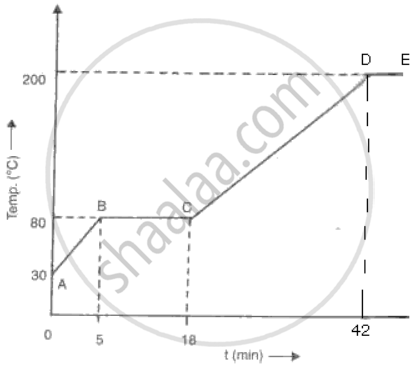
Frank solutions for Physics - Part 2 [English] Class 10 ICSE 5 Heat Exercise 3 [Page 247]
1 kg of molten lead at its melting point of 327°C is dropped in 1 kg of water at 20°C. Assuming no heat is lost; calculate the final temperature of water. (Sp. heat cap. of lead = 130 J/kg°C, Sp. latent heat of fusion of lead = 27000 J/g, Sp. heat cap. of water = 4200 j/kg°C)
How much steam at 100oC must be passed into 120 g of water at 20oC to raise the temperature to 40oC?
Heat is supplied at a constant rate to 200 g of ice at 0°C until finally all the ice is converted into steam at 100°C. If the specific latent heat of ice is 3.3 x 105 J/kg and that of steam is 2.3 x 106 J/kg and the Sp. heat capacity of water is 4200 J/kg, draw rough graphs for the following to illustrate the changes which take place as the solid ice is converted into water and finally into steam, the pressure remaining constant all the time.
(a) Volume against temperature,
(b) Temperature against time.
Give scientific reasons for the following:
It is much easier to skate on rough ice than on glass.
Give scientific reasons for the following:
Sand mixed with salt is often spread over the icy roads in winter.
Give scientific reasons for the following:
A steam burn is usually worse than a hot water burn.
Give scientific reasons for the following:
Bottled drinks are cooled more effectively when surrounded by lumps of ice than by cold water at 0°.
A bucket contains 10 liters of water at 80°C. Cold water at 25°C is run from a tap into the bucket of hot water for 20 seconds and the temp. Of the water in the bucket falls to 50°C.
(a) Calculate the rate at which cold water came out of the tap.
(b) State an assumption made in the above calculation.
650 J of heat is required to raise the temp. of 0.25 kg of lead from 15°C to 35°C. Calculate the Sp. heat capacity of lead.
A copper calorimeter weighing 57.5 g contains 60 g of water at 12°C. 55 g of iron nails at 100°C are dropped into the calorimeter ands stirred rapidly. The final temperature attained by the calorimeter and its contents is 20°C. Calculate the specific heat of iron. (Sp. heat of copper = 0.4 J/g°C, Sp. heat of water = 4.2 J/g°C).
1 kg of molten lead at its melting point of 327°C is dropped into 1 kg of water at 20°C. Assuming no loss of heat, calculate the final temp. of water. (Sp. heat of lead = 130 J/kg°C, latent heat of lead = 27000 J/kg and Sp. heat of water = 4200 J/kg°C).
Some heat is given to 120 g of water and its temp. rises by 10 K. When the same amount of heat is given to 60 g of oil, its temp. rises by 40 K. The Sp. heat of water is 4200 J/kgK. Calculate:
(a) The amount of heat in joules given to water,
(b) The specific heat capacity of the oil.
A block of lead of mass 250 g, at 27°C was heated in a furnace till it completely melted. Find the quantity of heat required
(a) To bring the lead block upto its melting point,
(b) To completely melt the block at its melting point (Melting point of lead is 327°C, Sp. heat cap. of lead is 0.13 J/gk and latent heat of fusion of lead is 26 J/g)
100 g of ice at -10°C is heated. It is converted into steam. Calculate the quantity of heat which it has consumed. (Sp. heat of ice = 2100J/kg°C, sp. heat of water= 4200 J/kgK, sp. heat of water = 42000 J/kgK, sp. latent heat of ice = 2260000 J/kg).
A refrigerator converts 100 g of water at 20°C to ice at -10°C in 73.5 minutes. Calculate the average rate of heat extraction from water in watt. (Sp. heat of ice= 2100 J/kgK, sp. heat of water = 4200 J/kgK, Sp. latent heat of ice = 336000 J/kg.)
(i) A molten metal weighing 150 g is kept at its melting point 800°C. When it is allowed to solidify at the same temp, it gives out 75000 J of heat. What is the specific heat of the metal?
(ii) If its specific heat capacity is 200 J/kgK? How much additional heat will it give out in cooling to -50°C?
40 g of ice at -16°C is dropped into water at 0°C, when 4 g of water freezes into ice. If specific heat capacity of ice is 2100 J/kg°C, what will be the latent heat of fusion of ice?
Calculate the time taken by an immersion heater, which supplies energy at the rate of 7000 J/minute to raise temp. of 5 kg water from 22°C to 47°C.
In an experiment. 17 g of ice is used to bring down the temp. of 40 g of water from 34°C to its freezing point. The sp. heat capacity of water is 4.25 J/g°C. Calculate sp. latent heat of ice.
What mass of ice at 0°C will be required to cool 0.9 kg of water from 35°C to 0°C? Assume all the ice used melts. The specific heat capacity of water is 4.2 x 103 J/kgoC and specific latent heat of fusion of ice is 336 x 103 J/kg.
Frank solutions for Physics - Part 2 [English] Class 10 ICSE 5 Heat Exercise 4 [Page 248]
State, with reason, which of the two, boiling water or steam both at 100°C will produce more severe burns.
Ice cream appears colder to the mouth than water at 0°C. Give a reason.
If 10125 J of heat energy boils off 4.5 g of water at 100°C to steam at 100°C, find the specific latent heat of steam.
Fill in the following blank using suitable word:
SI unit of heat is .........
Fill in the following blank using suitable word:
1 cal = .......... J
Fill in the following blank using suitable word:
Whenever mechanical work is done, .......... Is produced.
Fill in the following blank using suitable word:
Two bodies in contact are said to be in thermal equilibrium, if they have same ...........
Fill in the following blank using suitable word:
The normal temperature of a human body is .............
Fill in the following blank using suitable word:
SI unit of specific heat is ..........
Fill in the following blank using suitable word:
Ice at o0C is colder than ...........at o0C.
Fill in the following blank using suitable word:
Steam at 100oC is hotter than water at ............
Fill in the following blank using suitable word:
Evaporation causes ..........
Fill in the following blank using suitable word:
The amount of heat required to change the state of a physical substance without any change of temperature is called .......... of the substance.
Which has more heat: 1 g of ice at 0°C or 1 g of water at 0°C? Give reason.
Which contains more heat: 1 G water at 100°C or 1 g steam at 100°C? Give reason.
Which requires more heat: 1 g ice at 0°C or 1 g water at 0°C to raise its temperature to 10°C? Explain your answer.
Solutions for 5: Heat
![Frank solutions for Physics - Part 2 [English] Class 10 ICSE chapter 5 - Heat Frank solutions for Physics - Part 2 [English] Class 10 ICSE chapter 5 - Heat - Shaalaa.com](/images/physics-part-2-english-class-10-icse_6:39af211da77c495e91d1cf4305988990.PNG)
Frank solutions for Physics - Part 2 [English] Class 10 ICSE chapter 5 - Heat
Shaalaa.com has the CISCE Mathematics Physics - Part 2 [English] Class 10 ICSE CISCE solutions in a manner that help students grasp basic concepts better and faster. The detailed, step-by-step solutions will help you understand the concepts better and clarify any confusion. Frank solutions for Mathematics Physics - Part 2 [English] Class 10 ICSE CISCE 5 (Heat) include all questions with answers and detailed explanations. This will clear students' doubts about questions and improve their application skills while preparing for board exams.
Further, we at Shaalaa.com provide such solutions so students can prepare for written exams. Frank textbook solutions can be a core help for self-study and provide excellent self-help guidance for students.
Concepts covered in Physics - Part 2 [English] Class 10 ICSE chapter 5 Heat are Heat and Its Unit, The Temperature and a Thermometer, Thermal Capacity (Heat Capacity), Specific Heat Capacity, Relationship Between the Heat Capacity and Specfic Heat Capacity, Calorimetry and Calorimeter, Natural Phenomena and Consequences of High Specific Heat Capacity of Water, Some Examples of High and Low Heat Capacity, Heat and change of physical state, Factors Affecting the Quantity of Heat Absorbed to Increase the Temperature of a Body, Difference Between Heat and Temperature, Effect of Pressure on the Melting Point, Concept of Boiling (Vaporization), Effect of Impurities on the Melting Point, Change in Volume on Boiling, Effect of Pressure on the Boiling Point, Effect of Impurities on the Boiling Point, Melting and Freezing, Heating Curve of Ice During Melting, Change in Volume on Melting, Heating Curve for Water, Explanation of Latent Heat of Melting on the Basis of Kinetic Model, Specific Heat Capacity of Some Common Substances, Latent Heat and Specific Latent Heat, Natural Consequences of High Specific Latent Heat of Fusion of Ice, Principle of Method of Mixtures (or Principle of Calorimetry), Latent Heat and Specific Latent Heat.
Using Frank Physics - Part 2 [English] Class 10 ICSE solutions Heat exercise by students is an easy way to prepare for the exams, as they involve solutions arranged chapter-wise and also page-wise. The questions involved in Frank Solutions are essential questions that can be asked in the final exam. Maximum CISCE Physics - Part 2 [English] Class 10 ICSE students prefer Frank Textbook Solutions to score more in exams.
Get the free view of Chapter 5, Heat Physics - Part 2 [English] Class 10 ICSE additional questions for Mathematics Physics - Part 2 [English] Class 10 ICSE CISCE, and you can use Shaalaa.com to keep it handy for your exam preparation.
